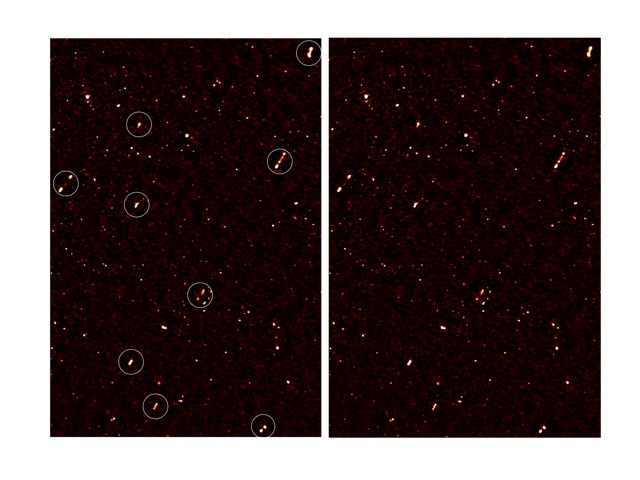Astronomers have discovered black holes that synchronized rotation over huge distances.

In the photo on the left, galaxies, in which the black holes in the center rotate in the same way, are circled
Astronomers from Cape Town University using the Giant Metrewave Radio Telescope (GMRT) radio telescope found an unusual picture in one of the distant corners of the Universe : several supermassive black holes send jets of radio emission in the same direction. Most likely, this behavior is caused by the influence of fluctuations of the primary mass formed in the early Universe.
This is the first observation of this kind. It became possible as a result of a three-year observation with the help of a radio telescope of a region of space called ELAIS-N1.
')
According to one of the authors of the work, Professor Andrew Russ Taylor, supermassive black holes located in the centers of galaxies can emit jets in one direction only if they all rotate in one direction.
“Since these black holes do not know anything about each other, and do not have the opportunity to exchange information or influence each other because of the huge distances separating them, the alignment of the directions of their rotation should have happened at the stage of galaxy formation,” he explains.
This means that there was a certain primary spin, which affected the appearance of such synchronicity in a huge part of the Universe - the study affects a region of the Universe with a size of about 100 Mpc (about 300 million light years). Although deviations from the isotropy of the Universe have met before, but never - on such scales that exceed the size of galactic clusters.
This discovery can clarify the concept of the formation of galaxies and their clusters. It is unclear exactly what factors could lead to the emergence of such a picture. Scientists offer only preliminary options: magnetic fields, fields associated with exotic particles , cosmic strings, and others. To clarify the theories will need additional research.
Giant Metrewave Radio Telescope (GMRT) is a radio telescope operating in India 80 kilometers north of the city of Pune, at an altitude of 588 meters above sea level. The world's largest radio telescope operating in the meter range. It consists of 30 antennas, each of which has a 45-meter reflector. In the area of the radio telescope, the level of radio interference generated by human activity is extremely low, so its large antennas at low frequencies are more productive than even the Very Large Array complex.
Source: https://habr.com/ru/post/392907/
All Articles